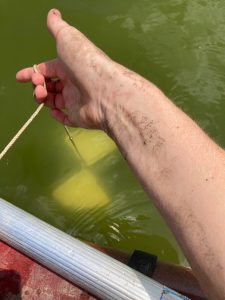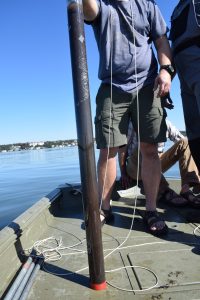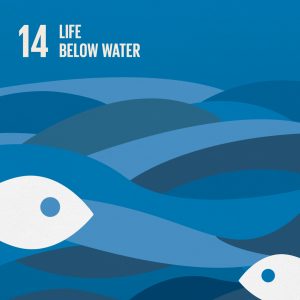By Savanna Wooten
In many ways Earth Day celebrations invite us to think of green: tree plantings, the advent of spring, conversations about renewable energy, convening at green spaces. And they should. Green – shown to benefit us mentally and physically – is, generally, good for us.
But… is it always?
Under balanced conditions, blue-green algae serve ecological roles as oxygen producers and food for small aquatic organisms. However, when provided the right combination of ingredients (e.g., warm, stagnant water and nutrients from the surrounding landscape), earth’s original photosynthesizers multiply readily, creating green blooms capable of dominating a lake’s surface.

Secchi disk measuring water clarity.
These harmful algal blooms (or “HABs”) can cause problems for just about everyone: monopolizing nutrients, oxygen and sunlight for aquatic life, and occasionally producing toxins which limit human access to recreation and food in addition to posing health risks.
Because of the widespread threats that HABs pose, lakes in bloom-prone areas are often monitored by lake professionals and volunteers, resulting in decades-long datasets used to: measure changes in water quality over time, set restoration targets, and identify conditions favorable to bloom formation.
However, while records such as these are usually high resolution and span multiple decades, their reach can still be limited.
For example, even the longest lake monitoring records are unable to capture what the lake was like before human influence (technically speaking, its “baseline conditions”), making it difficult to set historically accurate restoration targets. Similarly, many factors that influence lake health and bloom frequency occur on broad time scales that might not be captured within a few decades.
Fortunately, we can examine lake health and HABs from a variety of lenses… including ancient ones.

Vertical cores used for sampling.
Enter… paleolimnology (where “paleo” = ancient and “limnology” = the study of lakes and rivers). Researchers in this field take advantage of a natural lake process called sedimentation, where material sinks to the bottom of a lake and gets stored in chronological layers over time. Paleolimnologists collect vertical cores of this material and are then able to transform these deposits into timelines of lake change.
Within this field, researchers study all kinds of material stored in the mud (e.g., pollen, charcoal, higher-order algae, etc.) to help paint a picture of change. Often what we measure is not the thing itself, rather something reliable that represents it. For example, pollen represents surrounding vegetation, and charcoal represents fire frequency. We call these proxies.
The proxy our lab uses is photosynthetic pigments. Like plants, algae are able to turn sunlight into food, and pigments are fundamental to that process. Pigments make a great proxy because they “keep well” once buried in the mud (making them reliable), and they are unique to different algal community types (allowing us to see community change over time).
In the lakes I study, usually in Florida, we see a common trajectory play out: a long history of diverse algae communities, punctuated by big inputs of nutrients coinciding with periods of development, contributing to a persistent shift toward primarily bloom-forming algae in modern day. In other words, we see human activities place increasing pressure on lake systems, ultimately altering them in unprecedented ways.
Paleolimnologists also have the benefit of seeing what does and doesn’t work in terms of lake management and restoration. Many of these bloom-forming algae trends persist even after passage of legislation like the Clean Water and Clean Air Acts or after individual lake treatment plans have been executed. Among other culprits, this can be broadly attributed to non-point source pollution characteristic of the urban systems in which I study.
There has been a lot of time and money dedicated to healing the lakes I work with. But the sediment data often reveal these actions are not enough to restore the systems. Non-point source pollution is a nasty problem that is exacerbated in urban areas and contributes to harmful algal blooms in even the best managed systems.
But let’s return to “thinking green” once more…
As we approach Earth Day 2023, I am thinking of how to fight green with green. My research forces me to consider the differences green infrastructure could have on these systems, how well homeowner rain gardens or city-funded buffer wetlands might intercept the nutrient-rich runoff that permits algae to thrive.
This is a big problem to tackle, but in the meantime thank a green space this month, if only for keeping your water a little more blue.
Savanna Wooten is a PhD student within Crop, Soil and Environmental Sciences.
Learn about the SDGs & AU and our contributions related to this post.





